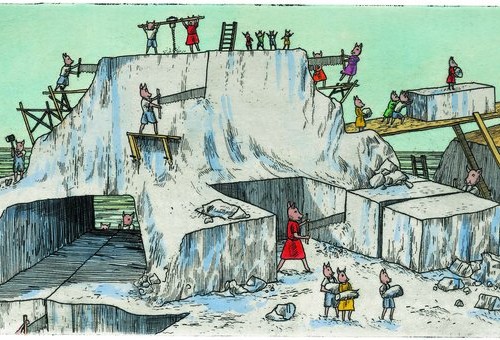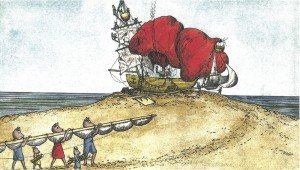I know a little something about ice. This winter has made me an expert. Last year, Edmonton broke a record for the quantity and in some respects, quality of snow that descended upon its shovel weary citizens, ending a multi-year drought and sending our city council into a tizzy of snow removal that was not only inadequate to the task, but a spectacular (and occasionally entertaining) public relations fiasco. This year, unlike any year in recent memory, we’ve had very little snow, some rain, ice-polishing gales, and a months-long cycle of freeze-thaw temperature variations. The landscape is pock-marked with pools of hard, lethal ice waiting to catch my rubber soles in a moment of inattention. Nevertheless, in summer when it’s unbearably hot, I will think back to winter’s icy grip with fondness, for there is nothing worse than unrelieved heat.
Just ask the pigs.
 In Arthur Geisert’s wordless Ice, a group of island-dwelling pigs are faced with a dilemma; their water supply is running low, and there are few if any trees to shelter them from the sun. Also, they are wearing overalls and high-necked dresses, and as any farmer will tell you, this is not appropriate clothing for pigs in the summer. (Tank tops and shorts are much cooler.) Not content to sit back and roast, the resourceful piggies gather around a table and devise a plan. It’s unclear what they are doing at first, but the entire porcine population from the adults to the piglets are engaged in the operation, hauling masts and other supplies to a ship moored on the shore. The schooner, a fantastical airship fueled by two giant cherry-red balloons, is soon aloft, sailing to an unnamed northern destination in search of a solution to the pigs’ predicament. An iceberg is located, and the porkers once again rise to the occasion, attaching a sail to the top of the berg. Those pigs think of everything.
In Arthur Geisert’s wordless Ice, a group of island-dwelling pigs are faced with a dilemma; their water supply is running low, and there are few if any trees to shelter them from the sun. Also, they are wearing overalls and high-necked dresses, and as any farmer will tell you, this is not appropriate clothing for pigs in the summer. (Tank tops and shorts are much cooler.) Not content to sit back and roast, the resourceful piggies gather around a table and devise a plan. It’s unclear what they are doing at first, but the entire porcine population from the adults to the piglets are engaged in the operation, hauling masts and other supplies to a ship moored on the shore. The schooner, a fantastical airship fueled by two giant cherry-red balloons, is soon aloft, sailing to an unnamed northern destination in search of a solution to the pigs’ predicament. An iceberg is located, and the porkers once again rise to the occasion, attaching a sail to the top of the berg. Those pigs think of everything.
Many hooves make light work, and by nightfall the entire crew is bound for home, some sailing with the vessel, others enjoying the coolness of the ice bobbing in tow behind the ship. Upon arrival, the ice is carved up like a…well, you know. Ever industrious, the pigs construct pulleys, platforms and cranes to cut and toss the ice into the reservoir, where it is used not just as replenishment for the water supply, but as entertainment. In the middle of a hot summer, ice is a joyful thing, and the pigs, while practical and focused, are not above enjoying an impromptu water slide.
I have long been a fan of Geisert’s work. His exquisitely etched illustrations are unique in the picture book oeuvre and are as instantly recognizable as his affable piggies, frequent players in Geisert’s quirky adventures. There is something so sensually pleasurable about his etchings, and etchings in general. Perhaps it’s the medium itself, which allows for such  beautifully precise details; endless busywork for the eyes of the reader, and quite obviously a boon for the imagination of someone like Geisert. Or maybe it’s the old world feel of an etched drawing, harkening back to the work of Albrecht Dürer, whose black & white engravings stir my heart far more than his paintings. In any case, Geisert’s island of pigs is beautiful work, even if the island itself is (apparently) a sandy wasteland, with nary a tree in sight. One wonders where the wood for the buildings originates, or how they feed themselves, and perhaps the biggest mystery of all, how the island came to support a band of pioneering pigs. Something to ponder for sure, but in the meantime it’s enough to lose oneself in the ingenious and unfailingly cheerful porcine problem-solving.
beautifully precise details; endless busywork for the eyes of the reader, and quite obviously a boon for the imagination of someone like Geisert. Or maybe it’s the old world feel of an etched drawing, harkening back to the work of Albrecht Dürer, whose black & white engravings stir my heart far more than his paintings. In any case, Geisert’s island of pigs is beautiful work, even if the island itself is (apparently) a sandy wasteland, with nary a tree in sight. One wonders where the wood for the buildings originates, or how they feed themselves, and perhaps the biggest mystery of all, how the island came to support a band of pioneering pigs. Something to ponder for sure, but in the meantime it’s enough to lose oneself in the ingenious and unfailingly cheerful porcine problem-solving.
 Originally trained as a sculptor in college, Geisert learned to etch at the Otis Art Institute in Los Angeles, CA. In spite of the meticulous amount of work involved in each project, Geisert has published just about a book a year for the past 30 years, all illustrated with his etchings. His work has appeared in The New Yorker and the Horn Book magazine, and in December, the New York Times selected Ice as one of the best illustrated books of 2011. A resident of Galena, a community in northwest Illinois, for decades, he currently lives in a converted bank building in Bernard, Iowa.
Originally trained as a sculptor in college, Geisert learned to etch at the Otis Art Institute in Los Angeles, CA. In spite of the meticulous amount of work involved in each project, Geisert has published just about a book a year for the past 30 years, all illustrated with his etchings. His work has appeared in The New Yorker and the Horn Book magazine, and in December, the New York Times selected Ice as one of the best illustrated books of 2011. A resident of Galena, a community in northwest Illinois, for decades, he currently lives in a converted bank building in Bernard, Iowa.
Ice by Arthur Geisert~published by Enchanted Lion Books, 2011. ISBN: 978-1592700981
For some additional fun, here’s a video of Geisert in his studio~
**As for my ‘expertise’ on the subject of ice…it’s now been several days since I began this post and in that time we’ve recieved 10 cm of snow, and the temperature no longer hovers between freeze and thaw, having dropped by 28 degrees to -32C as of this morning. My education as an iceologist has thus ended, as I can no longer see the ice. My eyes have frozen shut.



Ooh, I’d love to pour over this book! (and as it happens I’ve written about pigs today too 🙂 ) As a kid when we visited old stately homes I was always fascinated by the ice houses and the idea that people would store ice from the winter to use later in the summer.
Hmmm….
In northern Canada, we never seem to have a problem securing ice, but perhaps I’m being wistful. It’s hard to remember summer when it’s -32C outside.
I should ask the pigs!
Living in South India, snow is exotic, that is only seen in books and movies. I will ask pigs for some water during our dry droughts too.
When they once again report of our depleting quantities of icebergs, will someone now inquire with the pigs?
Absolutely. Given enough time, Global Pigging could be a very serious problem indeed.